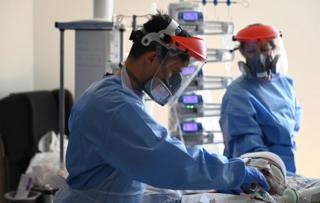Public spending on coronavirus soars to £190bn
 Image copyright Getty Images
Image copyright Getty Images Public spending on the battle against coronavirus has risen to nearly £190bn, according to figures released by the Treasury on Wednesday.
In his summer statement on Wednesday, the Chancellor announced a £30bn package to combat the crisis.
He also revealed that direct public spending on the crisis – excluding the new measures – had reached £158.7bn.
That takes the total for extra spending this year to around £190bn.
That total is nearly £3,000 for every person in the UK – and more than the entire planned health budget for 2020-21.
As recently as last month, the government’s spending watchdog, the Office for Budget Responsibility had estimated the figure at £133bn.
This extra spending is likely to push the gap between what the government spends and what it raises in taxes – the deficit – above the OBR’s latest estimate of around £300bn, according to the influential Institute for Fiscal Studies think tank.
‘Skated over’
Before the coronavirus outbreak began, the government was expecting a deficit of £55bn.
The extra public spending figure includes £15bn for spending on personal protective equipment such as gloves and masks.
It also includes £10bn for the testing and tracing of infected persons, taking the total extra spending on health services to £32bn.
«There is a huge public services additional spending that we didn’t really know about that was announced today. It was kind of skated over, but £15bn for PPE for frontline workers is an enormous sum,» Paul Johnson, director of the IFS, told the BBC.
He believes the Chancellor’s strategy is spend money now, to minimise long-term damage to the economy, which would ultimately cause more harm overall.
«I don’t think the Chancellor is desperately worried about the size of the deficit this year. What will concern him is the size of the deficit the year after, and the year after, and the year after that,» he said.
Other large measures include £4.7bn for local government, £5.3bn for public transport, and £4.1bn for Scotland, Wales and Northern Ireland.
However, the impact of the coronavirus on the public finances remains highly uncertain.
Of the policy measures announced on in the summer statement, the biggest was the plan to pay employers £1,000 for every furloughed worker they retain past January. The total bill could rise as high as £9.4bn, but only if every furloughed worker keeps their job.
There are some things no Chancellor can prepare for – such as what to do if your economy wipes out 18 years’ gains in two months of lockdown.
His solution was to temporarily deep freeze the economy, and pump money into crisis response. And the thawing process needs more funds, to prevent long term damage.
Now economists are talking about a deficit, a shortfall of way more than the £300bn previously expected. It’s equivalent to a bigger slice of the economy than at any time since the Second World War.
And it could get bigger; if more is needed to support the recovery – or in the event of a severe second wave.
But it’s a cost worth bearing if it carries the economy through a devastating crisis, safeguard the damage to output and jobs – and ensure taxes get paid.
For at some point, there will have to be a discussion about how we pay this back.
The government is currently borrowing record amounts on the financial markets to plug the gap – but that may not be enough. There may have to be tax hikes, possibly less generous rises in pensions.
But it may be a while until the economy is robust enough to bear that.



